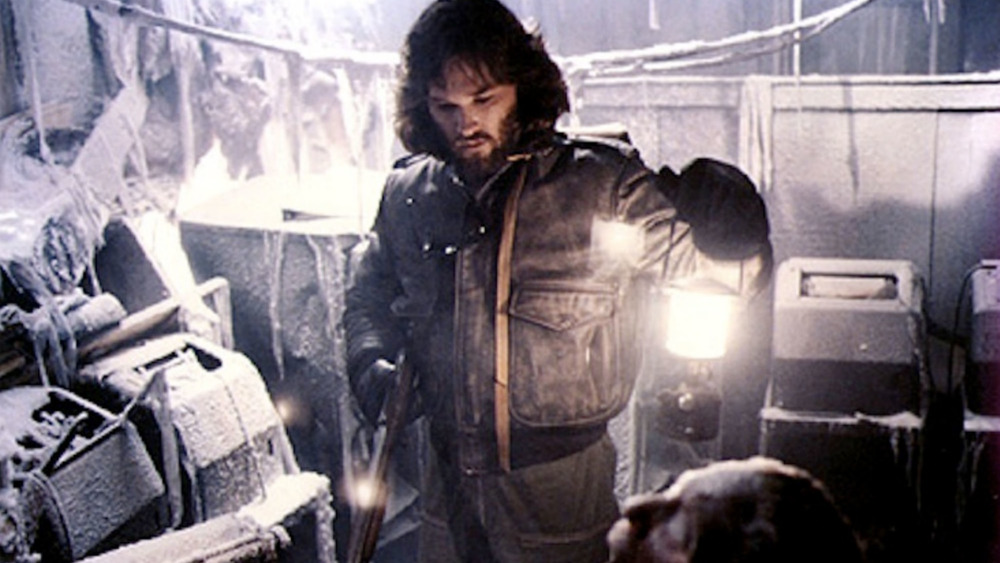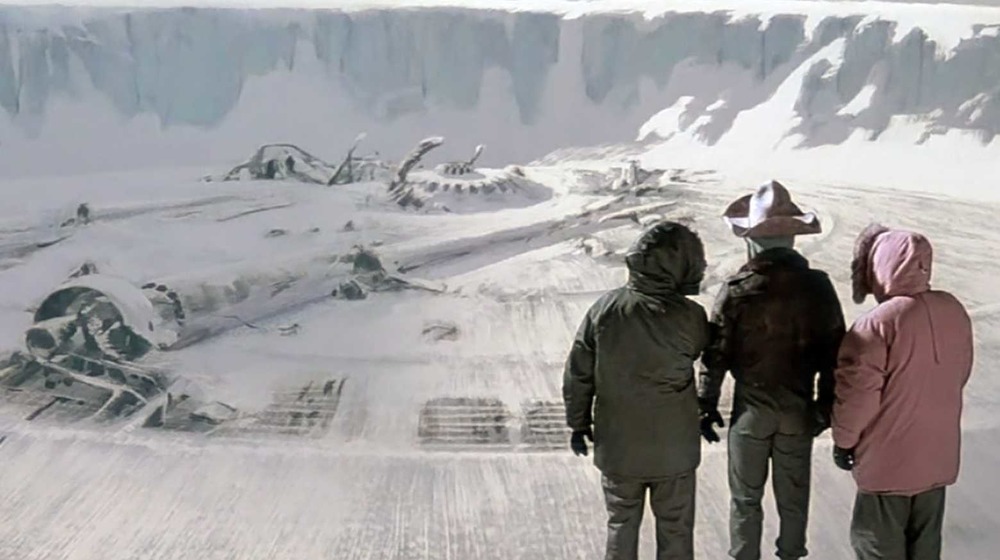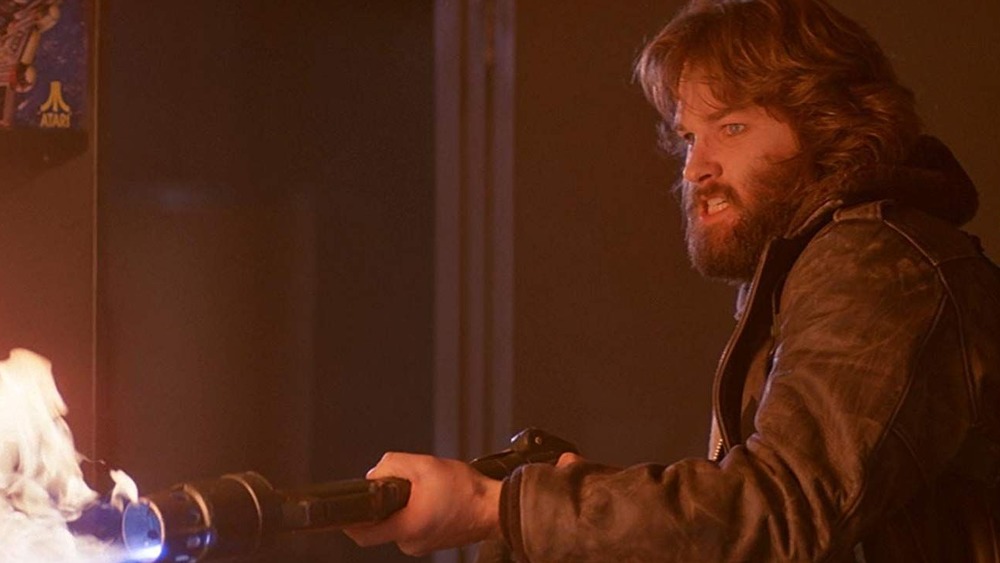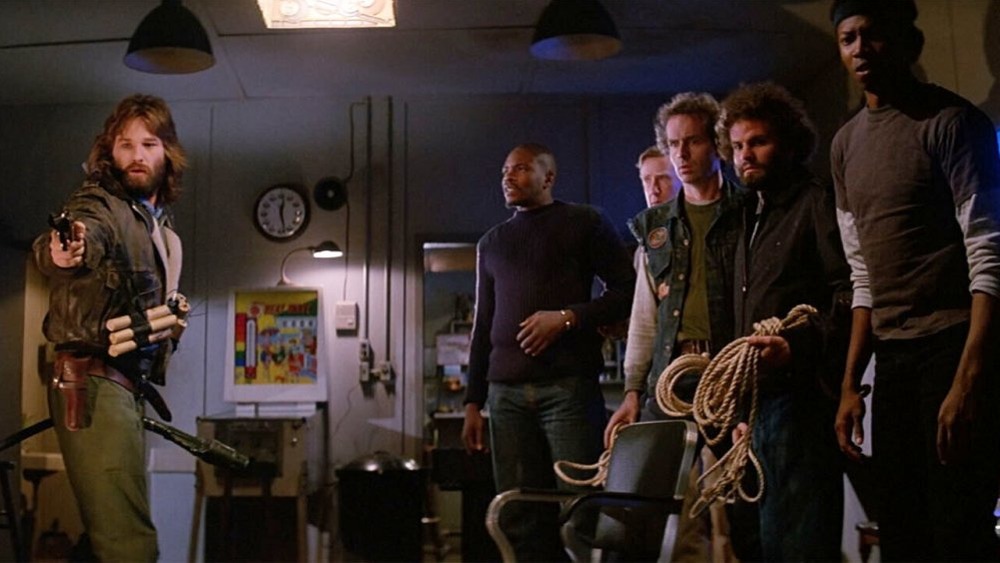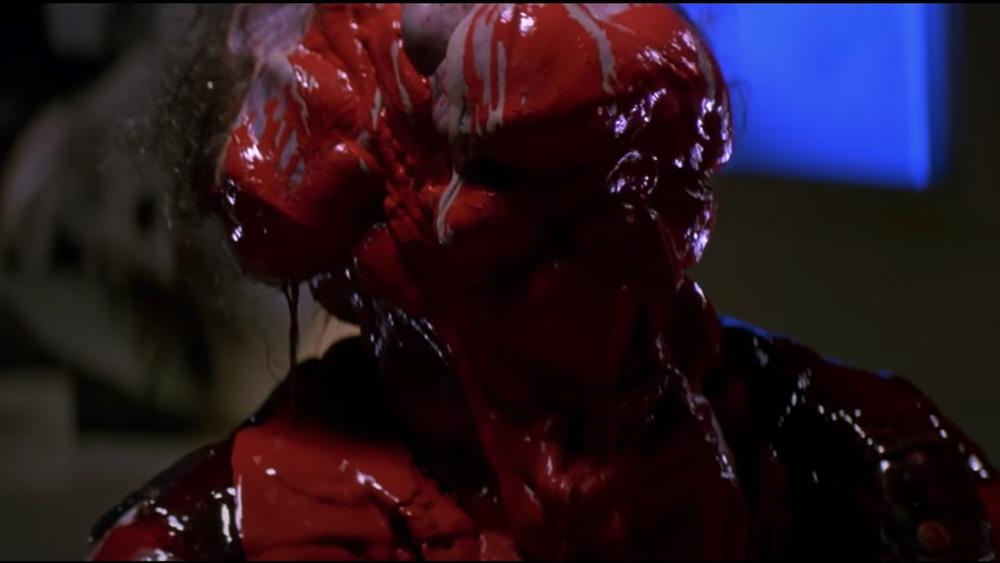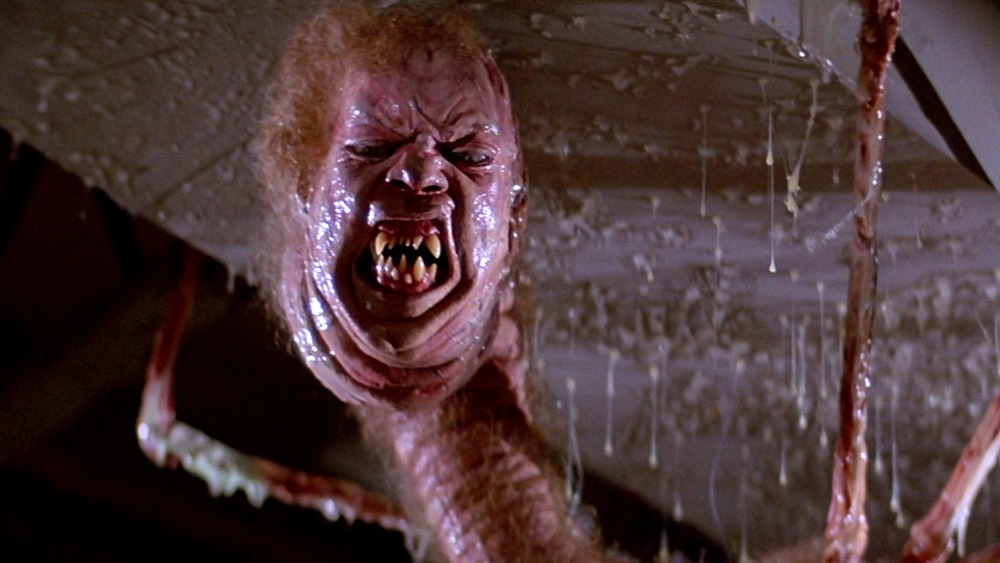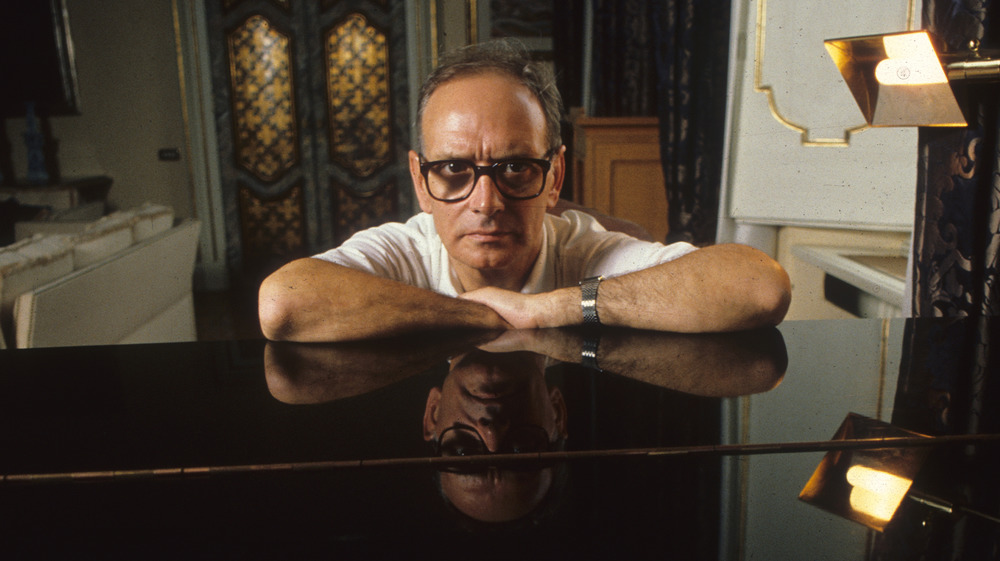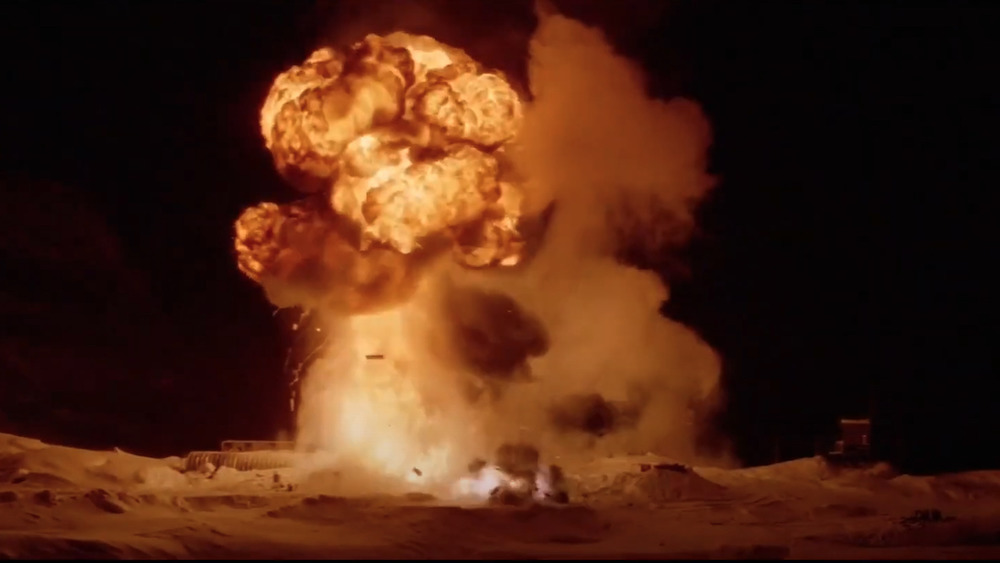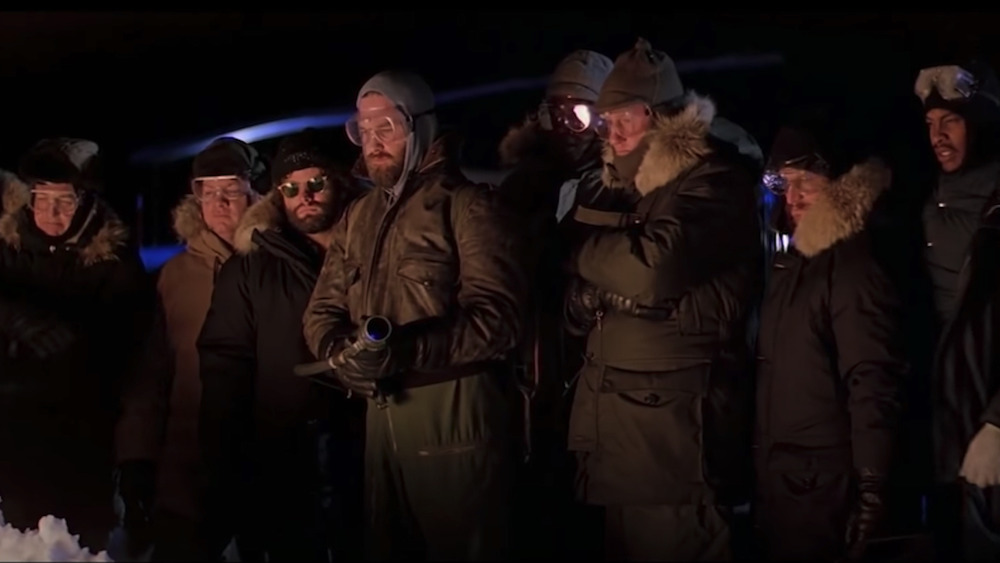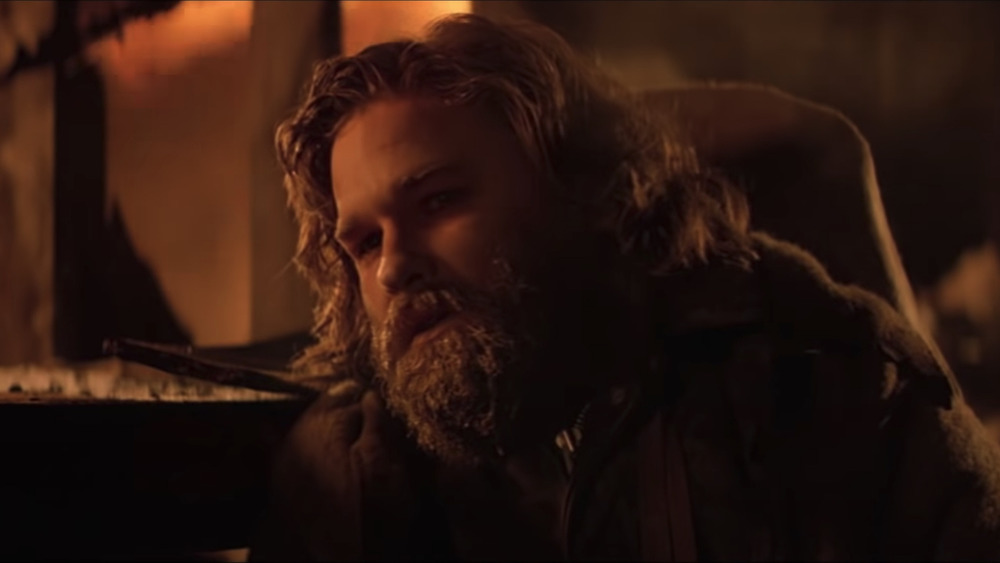Why The Thing Is The Best Sci-Fi Horror Movie Of All Time
John Carpenter's 1982 summer gross-out flick The Thing didn't invent the modern sci-fi horror genre. That honor goes to Ridley Scott's seminal Alien, released three years earlier. The science-fiction-horror hybrid is as old as science fiction itself — Mary Shelley's Frankenstein from 1818 could be considered the genre's first iteration. But Alien took advantage of a new aesthetic of '70s-era cinematic realism, along with a budding revolution in special effects, to reimagine the golden age sci-fi horror movies of the 1950s — those hammy classics about creatures from outer space and allegories about nuclear-age catastrophes. Cold War paranoia gave cinema immortal monster movies such as Godzilla, Invasion of the Body Snatchers, the giant-ant creep-fest Them! and Howard Hawks' original The Thing from Another World.
With its giant bug-monster, its human-incubating fetus, and its phobia of technology, Alien channels all the 1950s tropes. Its perfect balance of sci-fi and horror elements make it one of the classics of the genre, no doubt. But let's face it, it takes forever to get going. The last hour is pure terror, but there is a lot of build-up. The Thing, meanwhile, does everything that Alien does — both movies are versions of Agatha Christie's mystery novel And Then There Were None — and it also hits the ground running, starting with a grabber of an opening scene and keeping viewers on the edge of their seats until the final frame. Below we offer more reasons why John Carpenter's The Thing is the best sci-fi horror movie of all time.
The Thing perfectly balances elements of sci-fi and horror
Like Alien, The Thing features classic elements of both science fiction and horror. Sci-fi genre elements include an intelligent alien, a giant spaceship crashed on Earth, alien assimilation of humans, and a human/alien battle. Horror elements include monsters, an isolated setting, suspense, violence, and a haunted house of sorts, in which the scientists are trapped. Carpenter makes effective use of standard horror filmmaking techniques as well: low lighting, nighttime settings, jump scares, eerie music, and elaborate special effects makeup.
The Thing also weaves classic themes from the two genres. Both sci-fi and horror deal with chaos and the disruption of order, but horror films evoke the disruption of natural order, as in creating unnatural life in Frankenstein or Godzilla. Sci-fi on the other hand dramatizes the threat to the social order and civilization, as seen in films such as Independence Day and Invasion of the Body Snatchers. The alien in The Thing threatens the natural order by ripping apart than replicating human cells in a completely unnatural way. But its ability to assimilate humans so quickly also threatens civilization. The scientists realize they must stop the alien from leaving Antarctica and potentially assimilating the entire world population. The subtle and skillful way with which Carpenter and writer John Lancaster weave classic themes from both genres is one reason The Thing is the greatest all time sci-fi horror movie.
Kurt Russell in his prime is the perfect hero
If it seems like Kurt Russell has been in the movies since the age of the first nickelodeons, it's because he got his start as a child actor in the early 1960s, first in television, and later when Disney famously signed him to a 10 year contract for live-action fare. It was John Carpenter who helped Russell begin to shift his image from wholesome Disney kid into anti-hero and leading man, first in Elvis, the acclaimed 1979 TV biopic helmed by Carpenter, and then in his 1981 cult classic, Escape from New York, in which Russell embodies the eye-patched convict Snake Plissken. The actor pushes his anti-hero image even further in The Thing, playing R.J. MacReady, a helicopter pilot assigned to the Antarctic research station. MacReady is not a particularly nice guy. He drinks too much whiskey, he's a poor loser, and he's a recluse, cloistered in a shack apart from the others. He also has no compunction about killing to save his own skin.
But MacReady is also a born leader and man of action, radiating confidence and charisma behind one of cinema's great bushy beards. Even though Russell was only 30 at the time of production, his dramatic seasoning allowed him to comfortably lead the ensemble of experienced character actors, while still being young enough to bring the necessary athleticism to the part. And nobody has ever operated a flamethrower with as much determined panache as Russell does in The Thing.
A stellar ensemble cast surrounds Russell
The Thing is unusual for a horror movie in that it features no female characters. Many horror flicks revolve around a female lead character who is terrorized by, then ultimately dispatches, the monster. Examples include not only Alien, but also Carpenter's own classic, Halloween. If you're going to keep viewers interested in a movie that features mostly middle-aged dudes in parkas, you had better make them interesting. And this cast crackles. Like the cast of Alien, the actors bring an intense realism to their performances. When you're playing against bloody puppets and animatronic walking heads, the audience is only going to buy it if it seems as though the actors do.
Carpenter and the actors take what could easily be types and make them specific. Every performance is outstanding but there are several standouts alongside Russell. Wilford Brimley plays Blair, the senior biologist and the first to learn that the men are likely doomed. Roger Ebert once said of Brimley that he was incapable of an inauthentic line reading and that applies here in a movie that demands authenticity. Keith David as Childs, the company's chief mechanic, has brought his charismatic presence to acting for decades (he recently voiced the president in Rick and Morty) and he goes toe to toe with Russell as a determined survivor. Other standouts include L.A Law's Richard Dysart as Doc Copper and Donald Moffat as Garry, who runs the station and who utters the movie's funniest line.
The Antarctic setting is claustrophobic and terrifying
John Carpenter establishes Antarctica's vast frozen expanse early on in The Thing. MacReady and company are stuck there until spring, with only limited ability to travel outside U.S. Outpost 31. But the travel destinations available by chopper from their temporary home — a neighboring scientific station full of frozen bloody corpses, and the giant alien spaceship they discover — aren't exactly vacation spots.
The movie soon denies its characters even that limited mobility by trapping them in the outpost with a huge snowstorm. As the blizzard rages outside and the alien begins to stealthily assimilate them one by one, the men grow paranoid and suspicious of each other. When Blair's calculations tell him the alien will assimilate the entire world in a matter of hours should it escape Antarctica, he takes an axe to the communications equipment to prevent it. Already confined to the station, and facing the possibility of being assimilated, the men are now cut off from outside help as well.
Every great country house mystery needs a great country house, something expansive and labyrinthine and full of hidden chambers that the characters can't easily escape as they struggle to uncover the identity of the killer. The Thing has a great country house in the outpost designed by production designer John Lloyd. The claustrophobic research station surrounded by the sub-zero desolation of a frozen continent is one of the most original and effective settings in cinema.
The alien is a brilliant improvement on the 1951 version
Both Carpenter's film and the original Thing From Another World, directed by Christian Nyby (with an alleged assist from Howard Hawks), were based on the 1938 John W. Campbell Jr. novella Who Goes There? Although Carpenter was a fan of the original movie, he wanted his version to be a more faithful adaptation of the novella. Specifically, this meant a creepier and more intriguing alien. While Hawks' and Nyby's film certainly has its merits — and while it was a great influence on the sci-fi horror films that came after it — the monster is no great shakes. The thing is basically a guy in costume (James Arness) crashing through sets like Frankenstein. It may have played well to the audiences of the era, but it's not all that scary to modern moviegoers.
One of the aspects of Campbell's original story that attracted Carpenter was the alien's ability to imitate humans. This central conceit gives the remake both its underlying mystery — which characters are infected? who isn't what they appear to be? — as well as the sheer body horror on display. The idea that something we can't even see might invade our very cells and turn us inside out grabs us at a visceral level. The conceit also lends itself to all kinds of metaphors for the things humans are afraid of.
It features revolutionary special effects
The Thing is famous for its use of practical special effects to create gruesome scenes of the alien replicating dogs and humans. The movie was pre-digital — CGI was just getting off the ground in the summer of 1982 with Tron and Star Trek II: The Wrath of Khan – but there had been huge advancements in practical effects in the early '80s. Carpenter and practical FX whiz Rob Bottin (Robocop) use cutting edge animatronics, pyrotechnics, and prosthetic make-up to visualize its gore-fest. There is an awesome amount of work on the screen in the form of such delights as a multi-headed tentacled dog-monster, jaws that emerge from a man's chest to chomp off the arms of a colleague trying to give him CPR, and even a head that sprouts legs and ambles away. "You gotta be f**king kidding," one character says before MacReady torches the walking head with a flamethrower.
Although critics originally condemned the movie and its gore, there's no doubt that the inventive effects remain part of the movie's lasting appeal. Even though they don't look "real" by today's standards, they still inspire horror, disgust, and dread in the viewer. Compare them to the digital effects of the forgettable 2011 remake of The Thing, which are more photorealistic, but seems less real, and certainly less scary and disgusting. There's just something about dripping blood and slime that's more chilling and visceral when it's not made by a computer.
Ennio Morricone's classic creepy score
Ennio Morricone was already a legendary film composer by the time Carpenter brought him on board The Thing. He had written famous scores for Spaghetti Westerns such as The Good, the Bad and the Ugly, as well as music for classics such as Before the Revolution and The Battle of Algiers. He was revered by many filmmakers, including Quentin Tarantino, who has used his music in a number of his films, including The Hateful Eight. Tarantino has said that The Hateful Eight owes much to The Thing, including the icy setting, the snowed-in travelers, the use of Kurt Russell in the lead, and of course Morricone's music for Carpenter's film, some of which actually ended up in The Hateful Eight.
The brilliance of Morricone's score from The Thing is in its subtlety and simplicity. It mostly consists of a repeated low-register "thump-thump" refrain, underscored by some haunting minor key synthesizer. The refrain evokes the famous two-note refrain in Jaws, as well as the literal "bump in the night" that characterizes classic horror. It also uncannily evokes a human heartbeat, perhaps suggesting the racing heartbeats of the terrified characters (and viewers), as well as hearts literally stopping. Finally, its unhurried but relentless rhythm suggests the alien itself, methodically working its way through the men, unable to be stopped. The brilliance and sheer creepiness of Morricone's dark score is one of the reasons why The Thing is the best sci-fi horror film of all time.
It's a perfect allegory for the Cold War paranoia of the early 1980s
Like the sci-fi films of the 1950s, many films of the early 1980s dealt with doom-ridden eschatological fear, specifically the fear that our leaders were going to wipe humanity off the face of the earth with nuclear weapons. These included realistic dramas such as WarGames and the harrowing TV movie The Day After, as well as post-World War III sci-fi scenarios like The Road Warrior and The Terminator. These films, along with many others from the era, wrestled with the existential dread of nuclear holocaust.
The Thing is all about existential dread. Like the threat of nuclear war, the alien entity in the movie is unseen, could strike at any moment, and leads to the rearranging of human beings at the cellular level (in this way the alien is also a metaphor for deadly radiation). After the climactic holocaust at Outpost 31, the film ends with a detente of sorts, with the last two survivors agreeing to a wary peace. But it's a meaningless peace, as the rest of their world has been firebombed out of existence. As a (nuclear) winter falls, with burning ash drifting all around them, the survivors exist in a state of permanent distrust of one another — for what will likely be the remainder of a short and miserable existence. The movie could hardly be a more subtly powerful allegory for America's fear of nuclear apocalypse in the early 1980s.
The central mystery is meticulously worked out
The Thing became immediately infamous — and much reviled — for its shocking gross-out FX, which overwhelmed initial critics' and reviewers' responses to the film. They especially seemed to resent its association with Hawks' and Nyby's original, which is a model of classical hollywood filmmaking and gorgeous high contrast black and white cinematography. It was only as the remake was re-evaluated via cable and home video that viewers began to look past the gore and realize how sophisticated and layered Carpenter's vision really is. Perhaps the most sophisticated aspect is the set-up of the film's central mystery of who is infected by the alien and when they become infected.
As in And Then There Were None, the classic mystery that inspired Carpenter, the characters go down one by one while the survivors struggle to determine who has been assimilated. The story moves at such a breathless pace that the viewer doesn't have time to consider all the evidence on display. But a number of trenchant analyses — especially the much-viewed video breakdowns by Rob Ager — show just how meticulous Carpenter and Lancaster were at planting the evidence of infection. Ager follows the clues that the alien can only assimilate organic material, and not clothing, and seems to solve a long-standing mystery about the film's conclusion. To consume some of the online analysis and then screen the movie again makes quite clear the almost Hitchcockian command that Carpenter had over the film's mise-en-scene and cinematography.
The ambiguous ending is a classic
One of the things that didn't play well when The Thing first opened was its ambiguous ending. In fact Carpenter has said that he believes that the lack of closure was one reason for the film's box office failure. But fans and viewers have come to greatly appreciate the ambiguity of the ending over the years, both as a thematic statement on its own about the nature of paranoia, and as an invitation to figure out which of the surviving characters is infected (spoilers ahead).
At the climax of the movie, MacReady uses dynamite and Molotov cocktails made from whiskey bottles to blow up the camp and what he believes is the final iteration of the monster. But in the chaos and the parallel action that leads up to it, viewers lose track of where some of the characters have been — including MacReady and Childs, the last two survivors. It's possible that one or both of them could have been infected while they were offscreen. One long standing fan theory is that when MacReady gives Childs a drink from a whiskey bottle, the bottle contains gasoline (from making the Molotov cocktails), and not booze. When Childs drinks and doesn't react to the fuel, MacReady knows he is an alien. But Carpenter has never confirmed this, allowing generations of viewers the pleasure of theorizing what happened, and bucking the conventional wisdom that viewers always like their stories tied up neatly with no lingering questions.
